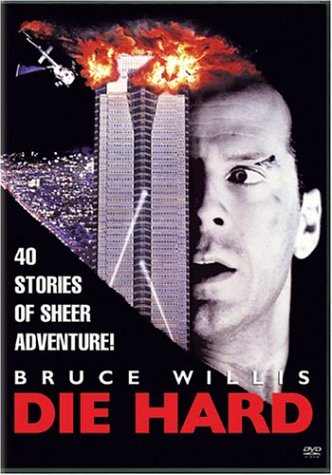Movie Review: Die Hard

The oldest of this summer’s franchises kicked off nearly twenty years ago with an unproven Bruce Willis becoming an unlikely action star. The then 33-year-old had made his name with TV’s quick-burning series Moonlighting, but it wasn’t long before this established Willis as a movie star.
With Predator director John McTiernan at the helm, Die Hard became the standard by which I compare almost every action movie to date. This is actually an interesting standard considering that the hard-boiled cop movies have been replaced by comic book action heroes in this day and age. It’s almost like movies or movie audiences couldn’t buy normal human beings doing extraordinary things anymore.
This is somewhat of a philosophical theme concerning hero John McClane (Willis). While this movie came a year before Tim Burton’s Batman began a renewed interest in comic book films, the Die Hard films have an anti-special-effects attitude, a flair for actual stunts over blue screen work. The character of McClane is inherently anti-technology, something that was actually consistent through all of the later films, including the upcoming summer sequel.
In Die Hard, New York cop John McClane has come out to L.A. to meet his wife Holly (Bonnie Bedelia), who has moved with the kids to advance her career at a booming Japanese corporation, Nakatomi. The move has put a strain on their marriage, but his visit to L.A. and Nakatomi’s Christmas party in a high-rise building is supposed to be a baby step into reaffirming their marriage. These personal matters will have to be put on hold, however, when Nakatomi is taken over by Hans Gruber (Alan Rickman in a star-making role) and his many hired goons, many of them Germans who can speak English.
John happens to be in the right place to evade the surprise attack, so he plots out how to be a hero while Gruber holds the Nakatomi employees, including Holly, hostage. Gruber seems to be a terrorist, but it seems he has other plans involving the Nakatomi vault. The unexpected McClane causes trouble, knocking off bad guys one-by-one while evading danger in the cramped spaces of the Nakatomi tower. Eventually, his efforts get the cops on the scene, including Sergeant Al Powell (Reginald VelJohnson), who becomes McClane’s supportive buddy on the outside. Meanwhile, non-bad guy antagonists like Deputy Police Chief Dwayne T. Robinson (Paul Gleason) and hungry reporter Richard Thornburg (William Atherton, resuming his jerky Ghostbusters duty) throw other challenges McClane’s way. There are plenty of surprises that await in this film, and the brilliance of Hans Gruber’s plan makes it all worth stopping.
The brilliance of the script comes from all the small details that come to play later: Holly using her maiden name at work becomes an essential part of the plot, as does an early suggestion by a guy sitting next to McClane on the plane to L.A. that leads to our hero being shoeless the whole time. The film builds believable challenges for McClane to overcome, making all of the action matter. Let’s not forget that Willis as McClane makes this picture. His performance, his interplay with Al Powell and Hans Gruber, add even more depth to a story that could have been a mindless action picture. One of my favorite scenes is when McClane faces off with Gruber goon Karl (Alexander Godunov) when the action becomes gloriously personal.
John McTiernan keeps the action unconfusing, with that great sense of place that many critics pine for when they discuss the best of action pictures. McTiernan hasn’t been quite as good since this and 1990’s The Hunt for Red October, but there was a stretch when he could do no wrong. The action pieces here are as good as it gets.
There’s also a memorable supporting cast in addition to the aforementioned: De’voreaux White as a limo driver, Hart Bochner as slimy Nakatomi negotiator Ellis, and who could forget Clarence “The Quarterback Is Toast” Gilyard, Jr. as Gruber’s tech Theo? Not to mention the agents Johnson and Johnson played by Robert Davi and Grand L. Bush.
Just about everything is perfect. There have been very few films that have approached it over the years: John Woo’s Hard-Boiled, Sam Raimi’s Spider-Man 2, and Paul Greengrass’s The Bourne Supremacy and United 93 have all been close over the years but nothing has combined all of the elements as effectively as the original Die Hard.
In 1988, Die Hard went on to become the 7th highest grossing film of the year, with a nearly $90 million take. Of course, inflation has skyrocketed film grosses over the years, and $90 million back then was a huge hit, especially for an R-rated film.
Next: Die Hard 2: Die Harder
Write a comment
You must be logged in to post a comment.